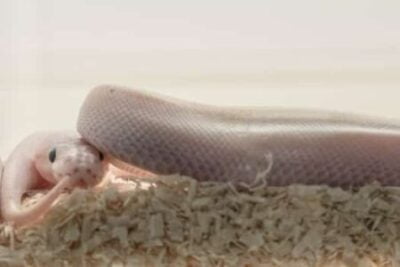High humidity can lead to scale rot, which is a bacterial infection of the ventral (belly) scales. According to the Veterinary Medicine Journal, scale rot (blister disease) can lead to death if left untreated. If your snake is at risk of blister disease, the tank will usually have a damp, moldy smell.
Reduce the humidity level in your snake’s tank by creating ventilation holes in the vivarium’s lid, or by replacing the lid with a mesh screen. Switch to a drier, moisture-absorbing substrate (Aspen or paper bedding.) Use a fan or dehumidifier in the room where you keep the vivarium. Replace the water bowl to the cool end of the enclosure.
Snakes need moisture, but the humidity level should be optimal for your species of snake. A ball python’s tank should ideally have a humidity level of around 55-60%, whereas a corn snake needs a lower level of humidity (around 40-50%). A simple way to get a reading is with a dehumidifier.
Why Do Snakes Need Humidity?
The term “humidity” describes how much water vapor is in the air.
Snakes usually live in a more humid, warmer environment. The natural moisture in the air helps their skin and respiratory tract to stay moist.
Snakes are far more accepting of too much humidity than too little. But, if a snake’s tank is too moist, this can cause scale rot (blister disease.)
How Much Humidity Does a Snake Need?
The humidity level in a snake’s enclosure should mimic its natural habitat. Here are the humidity requirements for different pet snakes:
| Snake Type | Approximate Humidity |
|---|---|
| Western Hognose Snake | 30-50% |
| Corn Snake | 40-50% |
| Milk Snake | 40-60% |
| California Kingsnake | 50-60% |
| Ball Python | 50-65% |
| Reticulated Python | 60-70% |
| Boa Constrictor | 60-75% |
| Brazilian Rainbow Boa | 70-80% |
Your snake requires ‘slightly’ more humidity during its shed cycle. This will help to prevent problem sheds, such as stuck eye caps and tail.
How to Measure Humidity in a Vivarium
The only visual indication of humidity is condensation appearing on the walls of the enclosure. Unfortunately, this only happens when humidity is around 100%, which is far too wet for a pet snake.
The only accurate way to judge your enclosure’s humidity level is to get a hygrometer. This is a device that measures the amount of water vapor in the air, and gives you a percentile reading.
There are analog and digital versions. The kinds with a probe tend to be the most accurate. Place the probe just above the substrate, where your snake will be spending its time, to get the most precise readings.
Humidity Too High in a Snake’s Cage
If your enclosure’s humidity too high, you should do the following:
Move the Water Bowl
Snake vivariums have a “cool end” and a “warm end.” The warm end will be the end which is heated, either with a UTH (under-tank heater) or an overhead heat emitter. This provides your snake with a heat gradient, enabling it to regulate its body temperature.
If your snake’s water dish is in the warm end, move it to the cool end. Keeping the water dish cooler will lead to lower humidity. According to Science Daily, evaporation happens faster at higher temperatures.
Use a Smaller Water Bowl
Reducing its size of a snake’s water bowl by just an inch in diameter will provide less surface area for water to evaporate.
Your snake needs a water bowl that is big enough for it to be partially submerged in, should it feel the need to bathe.
Increased Ventilation
Warm air rises, so creating some holes and vents in your snake’s enclosure will allow the humid air to escape and cool, drier air to flow back in.
If your snake is living in a plastic tub, this will involve drilling some small holes in the lid and sides.
Alternatively, you could replace the plastic lid with a mesh screen, which will allow for much more ventilation.
Use a Heat Mat, Not a Heat Lamp
Your snake’s living environment will be drier if you heat it from above.
Heat mats and heat tape provide heat from below. Others, such as ceramic heat emitters and heat bulbs, send heat down from above.
A heat mat encourages any moisture on the bottom of the vivarium to evaporate, thus increasing the level of humidity.
A heat source projecting downwards into the vivarium will dry out the air. So, swap your snake’s heat mat for a ceramic heat bulb.

Get a Dehumidifier / Oscillating Fan
Depending on where you live in the world, and your home’s environment, it could be that the humidity levels in your home are too high for your snake.
Consider getting a dehumidifier. You can also use an oscillating fan, pointed at your snake’s enclosure, to help move the humid air away.
Switch to a Glass Enclosure
Plastic enclosures hold on to more humidity than glass terrariums. This is because plastic is much better at retaining heat.
If you keep your snake in a plastic tank and are finding it hard to bring the humidity down, switch to a glass tank, or a wooden tank with glass doors.
Change the Substrate (Bedding)
Some substrates can be naturally damp and tend to disperse lots of moisture into their air. Others are drier, and can soak up moisture naturally from the environment, thus keeping the air dry.
Switch your snake’s bedding to Aspen, newspaper, or paper pulp (such as Carefresh). Remember to change the substrate whenever it feels too damp.
If your snake’s tank is too humid, use the above strategies to optimize the level. Ball pythons, corn snakes, retics, boas, kingsnakes, etc. all need different humidity settings, based on their species, in order to stay healthy.

